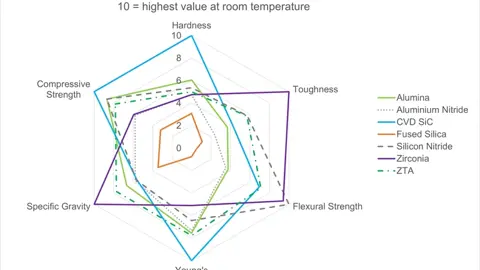Technical Ceramics

Toughness
Contact usTensile Strength
Ceramics generally have low fracture toughness, so it is good design practice to avoid or minimise tensile stresses in an application when designing a ceramic part. Because tensile tests can be difficult to perform on ceramic test coupons, tensile strengths often are not listed on ceramic property data sheets. Instead, the data sheet list bending strength and compression strength. Generally, the compression strength of a ceramic is about 10x higher than the tensile strength, and the bending strength is about 5x higher than the tensile strength.
Fracture Toughness
A material’s fracture toughness, or its ability to resist crack propagation, can be described by a parameter call critical stress intensity factor, KIC. Essentially, a material with a high KIC value can absorb more energy before fracture versus a material with a lower KIC value. Compared to metals, ceramics have a low KIC value. Although, at temperatures close to a ceramic’s softening point, ceramics can fail in a ductile manner rather than the usual brittle fashion.
Compared to other ceramics, silicon nitride, zirconia, and zirconia toughened alumina have relatively high toughness with KIC values of 10 or higher.
Ceramic matrix composites (CMC) have been introduced to further increase ceramics’ ability to resist fracture as well as resisting thermal shock, particularly for applications within aircraft gas turbine engines. Such CMC examples include an alumina matrix reinforced with along alumina fibers (known as Ox-Ox) or a silicon carbide matrix reinforced with long silicon carbide fibers (known as SiC-SiC).
|
Material |
Grade |
KIC |
|---|---|---|
|
Zirconia |
>12 |
|
|
Zirconia |
12 |
|
|
Zirconia |
10 |
|
|
Zirconia |
10 |
|
|
Alumina |
4.6 |
|
|
Alumina |
4.5 |
|
|
Alumina |
4.0 |
|
|
Alumina |
3.6 |
|
|
Alumina |
3.5 |
|
|
Silicon Carbide |
PGS3 |
3.3 |
|
Silicon Carbide |
PS5000 |
3.3 |
|
Silicon Carbide |
2.9 |
|
|
Glass Ceramic |
1.5 |
View our material datasheets here
Stress Crack Corrosion
Whereas the KIC parameter informs at what value of load a crack will rapidly propagate to cause a brittle fracture, cracks can also propagate slowly overtime at lower loads, and then rapidly propagate after the crack has grown to a certain critical length for the given load level.
The propensity for a crack to grow can worsen in certain environments such as water or humid air. This phenomenon is named stress crack corrosion, or subcritical crack propagation, and can be a consideration for metals and plastics, as well as ceramics.
To inform the designer, SPT diagrams for a material illustrate the relationship between the stress (S) applied to the material, the probability (P) of failure of the material under that stress for a given duration of time (T). For a desired design lifetime, to reduce the probability of stress crack corrosion, the maximum design load is simply reduced.
Ceramics’ Tailored Set of Mechanical Properties
While individually discussing each mechanical property of a ceramic there is a risk of overlooking the broad array of combined mechanical attributes that ceramics offer. Plotting the breadth of mechanical properties of the varied technical ceramic helps illustrate the breadth of engineered possibilities that ceramics provide. Diverse electrical, thermal, and chemical properties of these materials offer the engineer a wide array of choices.




